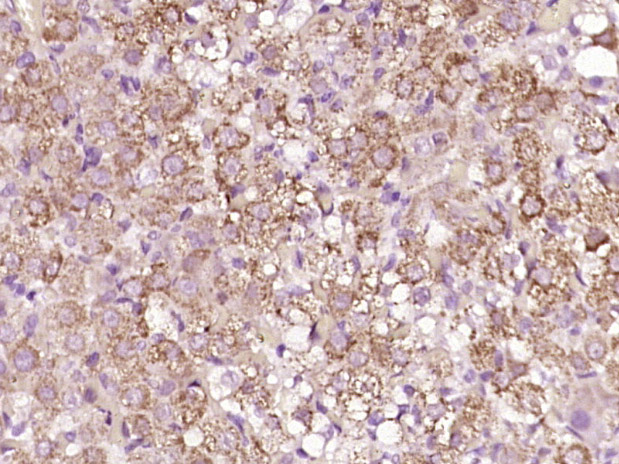
Rabbit Anti-HSD3B2 antibody
3BHS2_HUMAN; 3 beta-hydroxysteroid dehydrogenase/Delta 5-->4-isomerase type 2; 3 beta-hydroxysteroid dehydrogenase/Delta 5-->4-isomerase type II (3-beta-HSD II); 3-beta-HSD adrenal and gonadal type; 3-beta-hydroxy-Delta(5)-steroid dehydrogenase; EC:1.1.1.
View History [Clear]
Details
Product Name HSD3B2 Chinese Name 3β-羟基类固醇脱氢酶/δ5->4-异构酶2型抗体 Alias 3BHS2_HUMAN; 3 beta-hydroxysteroid dehydrogenase/Delta 5-->4-isomerase type 2; 3 beta-hydroxysteroid dehydrogenase/Delta 5-->4-isomerase type II (3-beta-HSD II); 3-beta-HSD adrenal and gonadal type; 3-beta-hydroxy-Delta(5)-steroid dehydrogenase; EC:1.1.1.145; EC:1.1.1.145; Progesterone reductase; Steroid Delta-isomerase; EC:5.3.3.1; Delta-5-3-ketosteroid isomerase; HSDB3B; HSDB; HSD3B; SDR11E2; literatures Research Area Cell biology Signal transduction Growth factors and hormones The new supersedes the old Mitochondrion Immunogen Species Rabbit Clonality Polyclonal React Species (predicted: Human, Dog, Pig, ) Applications ELISA=1:5000-10000 IHC-P=1:100-500 IHC-F=1:100-500 ICC=1:100-500 IF=1:100-500 (Paraffin sections need antigen repair)
not yet tested in other applications.
optimal dilutions/concentrations should be determined by the end user.Theoretical molecular weight 40kDa Cellular localization cytoplasmic Mitochondrion Form Liquid Concentration 1mg/ml immunogen KLH conjugated synthetic peptide derived from human HSD3B2 Lsotype IgG Purification affinity purified by Protein A Buffer Solution 0.01M TBS(pH7.4) with 1% BSA, 0.03% Proclin300 and 50% Glycerol. Storage Shipped at 4℃. Store at -20 °C for one year. Avoid repeated freeze/thaw cycles. Attention This product as supplied is intended for research use only, not for use in human, therapeutic or diagnostic applications. PubMed PubMed Product Detail Predicted to enable 3-beta-hydroxy-delta5-steroid dehydrogenase activity and steroid delta-isomerase activity. Predicted to be involved in several processes, including hippocampus development; response to corticosterone; and steroid hormone biosynthetic process. Predicted to be located in several cellular components, including intercellular bridge; mitochondrial envelope; and nucleolus. Predicted to be active in cytoplasm and intracellular membrane-bounded organelle. Is expressed in liver. Human ortholog(s) of this gene implicated in hypertension and hypospadias. Orthologous to human HSD3B1 (hydroxy-delta-5-steroid dehydrogenase, 3 beta- and steroid delta-isomerase 1) and HSD3B2 (hydroxy-delta-5-steroid dehydrogenase, 3 beta- and steroid delta-isomerase 2). [provided by Alliance of Genome Resources, Apr 2022]
Function:
3-beta-HSD is a bifunctional enzyme, that catalyzes the oxidative conversion of Delta(5)-ene-3-beta-hydroxy steroid, and the oxidative conversion of ketosteroids. The 3-beta-HSD enzymatic system plays a crucial role in the biosynthesis of all classes of hormonal steroids.
Subunit:
Expressed in adrenal gland, testis and ovary.
Subcellular Location:
Endoplasmic reticulum membrane. Mitochondrion membrane.
Tissue Specificity:
Defects in HSD3B2 are the cause of adrenal hyperplasia type 2 (AH2) [MIM:201810]. AH2 is a form of congenital adrenal hyperplasia, a common recessive disease due to defective synthesis of cortisol. Congenital adrenal hyperplasia is characterized by androgen excess leading to ambiguous genitalia in affected females, rapid somatic growth during childhood in both sexes with premature closure of the epiphyses and short adult stature. Four clinical types: 'salt wasting' (SW, the most severe type), 'simple virilizing' (SV, less severely affected patients), with normal aldosterone biosynthesis, 'non-classic form' or late onset (NC or LOAH), and 'cryptic' (asymptomatic). In AH2, virilization is much less marked or does not occur. AH2 is frequently lethal in early life.
Note=Mild HSD3B2 deficiency in hyperandrogenic females is associated with characteristic traits of polycystic ovary syndrome, such as insulin resistance and luteinizing hormon hypersecretion.
DISEASE:
Defects in HSD3B2 are the cause of adrenal hyperplasia type 2 (AH2) [MIM:201810]. AH2 is a form of congenital adrenal hyperplasia, a common recessive disease due to defective synthesis of cortisol. Congenital adrenal hyperplasia is characterized by androgen excess leading to ambiguous genitalia in affected females, rapid somatic growth during childhood in both sexes with premature closure of the epiphyses and short adult stature. Four clinical types: 'salt wasting' (SW, the most severe type), 'simple virilizing' (SV, less severely affected patients), with normal aldosterone biosynthesis, 'non-classic form' or late onset (NC or LOAH), and 'cryptic' (asymptomatic). In AH2, virilization is much less marked or does not occur. AH2 is frequently lethal in early life.
Note=Mild HSD3B2 deficiency in hyperandrogenic females is associated with characteristic traits of polycystic ovary syndrome, such as insulin resistance and luteinizing hormon hypersecretion
Similarity:
Belongs to the 3-beta-HSD family.
SWISS:
P26439
Gene ID:
3284
Database links:Entrez Gene: 3284 Human
Entrez Gene: 15493 Mouse
SwissProt: P26439 Human
SwissProt: P26149 Mouse
Product Picture
Bought notes(bought amounts latest0)
No one bought this product
User Comment(Total0User Comment Num)
- No comment



 +86 571 56623320
+86 571 56623320
 +86 18668110335
+86 18668110335

